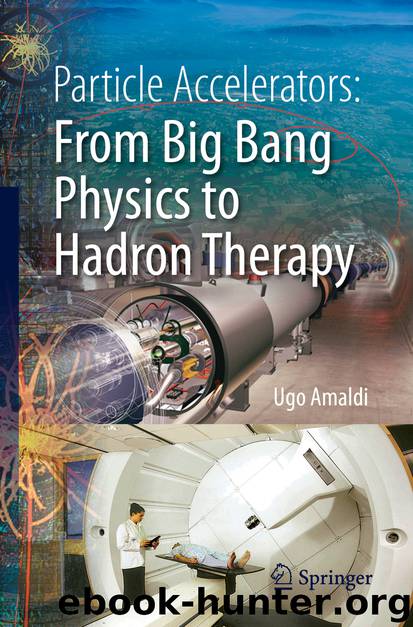Particle Accelerators: From Big Bang Physics to Hadron Therapy by Ugo Amaldi

Author:Ugo Amaldi
Language: eng
Format: epub
Publisher: Springer International Publishing, Cham
The gauge symmetry is not a symmetry of space but a symmetry of the field which describes matter-particles. In the case of the electronic field, this symmetry property implies the existence of a force field which can be identified as the ‘photonic’ field (usually called the ‘electromagnetic’ field) and has just one associated force-particle, the photon. Similarly, from the requirement that the three quark fields u r, u g and u b (and all the other triplets of quark fields) are subject to an analogous form of gauge symmetry, it follows that eight force fields should exist, whose quanta are the familiar eight gluons.
Applying the gauge symmetry principle to the electronic and quarkonic fields leads thus to both the electric force and the strong force: the existence of nine force-particles (one photon and eight gluons) follows from the two gauge symmetries and need not to be introduced as independent hypotheses.5
But there is more. For reasons it is not possible to explain here, in every gauge field theory the mass of the force-particles should be exactly zero. This actually does correspond to photons, gluons and gravitons, mediators of the gravitational force, as indicated in Table 5.1 of p. 124. In this respect photons and gluons appear very similar.
Nevertheless they are also very different, because the strong force produces events similar to the one shown schematically in Fig. 5.11b, which manifests itself as a four-jet event, while events in which the three gluons of this figure are replaced by three photons cannot exist and in fact have never been observed.
Four-jet events are characterised by a quantity called the ‘triple gluon vertex’ – indicated in Fig. 5.11b – which determines the probability of the emission of a gluon by another gluon. It is a very important quantity in quantum chromodynamics, because it implies that gluons interact with themselves forming the ‘gluon elastics’ depicted in Fig. 5.8 (p. 135); as a consequence the strong forces increases indefinitely when a quark and an antiquark are separated. The ‘triple-photon vertex’ does not exist and the electromagnetic force decreases with the distance. A measurement of the triple gluon vertex was made in Spring 1990 by the DELPHI collaboration – only 1 year after the first electron-positron annihilations in LEP – and I had the great satisfaction to present it at the international particle physics conference which was held in Singapore in August of the same year. As I will explain in Chap. 8, this event had a major influence on the rest of my professional life.
Download
This site does not store any files on its server. We only index and link to content provided by other sites. Please contact the content providers to delete copyright contents if any and email us, we'll remove relevant links or contents immediately.
Tools of Titans by Timothy Ferriss(7811)
Turbulence by E. J. Noyes(7700)
Astrophysics for People in a Hurry by Neil DeGrasse Tyson(5000)
Secrets of Antigravity Propulsion: Tesla, UFOs, and Classified Aerospace Technology by Ph.D. Paul A. Laviolette(4990)
Design of Trajectory Optimization Approach for Space Maneuver Vehicle Skip Entry Problems by Runqi Chai & Al Savvaris & Antonios Tsourdos & Senchun Chai(4839)
Room 212 by Kate Stewart(4732)
Pale Blue Dot by Carl Sagan(4613)
The David Icke Guide to the Global Conspiracy (and how to end it) by David Icke(4377)
A Journey Through Divination and Astronomy by Publishing Pottermore(4248)
Apollo 8 by Jeffrey Kluger(3512)
Goodbye Paradise(3444)
Losing the Nobel Prize by Brian Keating(3425)
COSMOS by Carl Sagan(3346)
The Five People You Meet in Heaven by Mitch Albom(3334)
How to Read Water: Clues and Patterns from Puddles to the Sea (Natural Navigation) by Tristan Gooley(3239)
Brief Answers to the Big Questions by Stephen Hawking(3239)
How to Read Nature by Tristan Gooley(3077)
The Order of Time by Carlo Rovelli(3073)
A Brief History of Time by Stephen Hawking(2819)
